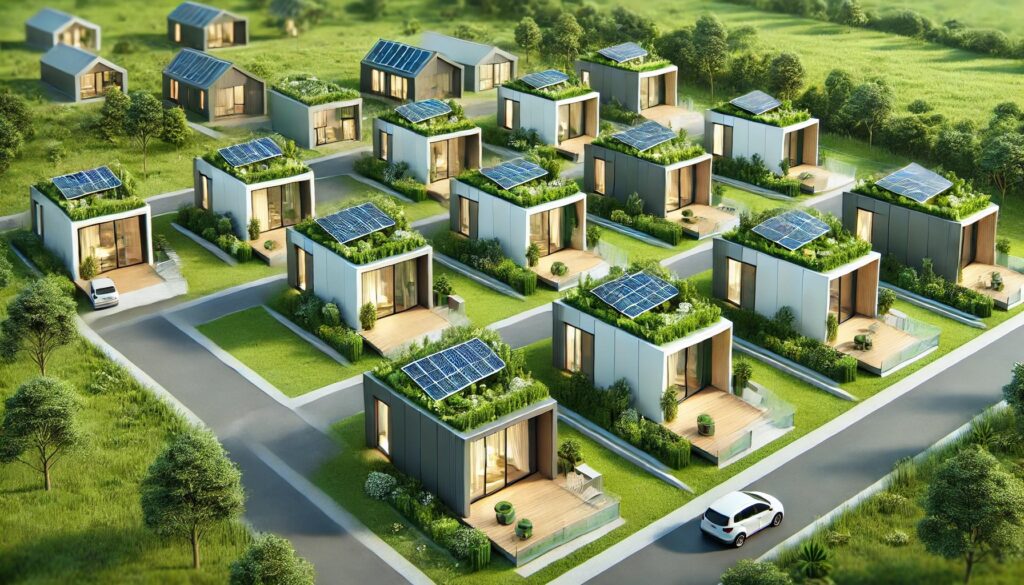Imagine a world where your home predicts your energy needs, your city cuts waste by half, and affordable housing doesn’t harm the planet. Sounds futuristic? It’s happening right now in the USA, thanks to AI-driven green tech. Most people don’t naturally pair AI with sustainability, but here’s the secret: this duo is quietly rewriting America’s future. In 2025, as housing costs soar and climate challenges mount, these innovations are more than trendy—they’re essential. Let’s unpack how AI-driven green tech is changing lives across the nation.
Why AI-Driven Green Tech Is a Game-Changer
The USA is at a crossroads. Monthly housing costs hit a record $3,104 in January 2025 (Cryptopolitan), while a 3.8 million home shortage looms (Realtor.com). Add rising homelessness—770,000 people in 2024, per the CBPP—and it’s clear we need solutions fast. AI-driven green tech steps in with sustainable AI innovations that optimize resources, slash emissions, and make life more affordable. Think of it as brains meets eco-heart, powering a greener, smarter America.
How AI and Green Tech Are Transforming Lives
Smart Homes, Smarter Savings
In states like Texas, AI-driven thermostats adjust heating based on weather forecasts, saving homeowners 10-12% on bills—about $150 yearly, says Google. Pair that with solar panels, and families in sunny Arizona are banking up to $1,500 annually (EIA). It’s not just money; it’s cleaner air too.
Cities That Think Green
Take Seattle: AI sorting systems boosted recycling rates by 60%, diverting trash from landfills. In Austin, AI traffic management cuts commute times by 15%, reducing emissions. These eco-friendly AI trends mean less pollution and more time for what matters.

Housing Hope Amid Crisis
After DOGE slashed the $1 billion Green and Resilient Retrofit Program in 2025, AI-driven green tech offers a lifeline. In Oregon, pilot projects use AI to design modular homes—built 20% faster, 30% greener (DOE). These sustainable AI solutions could ease the housing crunch if scaled up.
Real-Life Examples: AI-Driven Green Tech in Action
- Arkansas Lead Cleanup: Before funding cuts, LISC used AI to pinpoint lead paint in homes, protecting kids’ health. Stalled now, but a model for what’s possible.
- Maine Mill Revival: AI optimized renovations turned an old mill into affordable, energy-efficient housing—a blueprint for rural renewal.
- California Solar Surge: AI-powered grids in Sacramento balance solar energy, powering 50,000 homes with zero waste (EIA).
These cases show AI-driven green tech isn’t theoretical—it’s tangible, impactful, and American-made.
The Stats Behind the Shift
| Impact Area | Result | Source |
|---|---|---|
| Home Energy Savings | $1,500/year (solar homes) | EIA |
| Housing Costs | $3,104/month average | Cryptopolitan |
| Recycling Boost | 60% more in Seattle | Local Reports |
| Modular Home Efficiency | 30% lower emissions | DOE |
Featured Snippet Opportunity
Question: What is AI-driven green tech?
Answer: AI-driven green tech combines artificial intelligence with sustainable practices to optimize energy, reduce waste, and improve lives—like smart grids and green homes in the USA.
Challenges to Overcome
AI isn’t perfect. Training models can consume massive energy, ironically clashing with green goals. But companies like Google are countering this with renewable-powered data centers, cutting AI’s carbon footprint by 20% in 2024. Cost is another hurdle—small towns can’t always afford the upfront investment. Yet, the long-term payoff in jobs (37 GW of solar by 2030, WatchWire) and savings makes it worth the push.
A Unique Perspective: The Unsung Hero of Sustainability
Here’s what others miss: AI-driven green tech isn’t just about gadgets—it’s about empowerment. It gives communities tools to fight back against crises like housing shortages or climate disasters. In Florida, AI predicts floods, saving billions and lives. That’s not tech for tech’s sake; it’s tech for people. This human-centric angle is the secret sauce to its success in 2025.
What’s Next for the USA?
The future of green technology USA impact hinges on adoption. Businesses can tap sustainable AI innovations for efficiency—check our guide to AI sustainability for steps to start. Individuals can push for local projects or adopt smart devices. With homelessness rising and costs climbing, AI-driven green tech could be the bridge to a stable, sustainable tomorrow.
Join the Green Tech Revolution
AI-driven green tech is here, transforming the USA one home, one city at a time. Want to dig deeper? Explore more at aigreenusa.com or share your thoughts below—how’s this tech touching your life? Let’s keep the conversation going!
NOTE:- “all image was generated using AI.